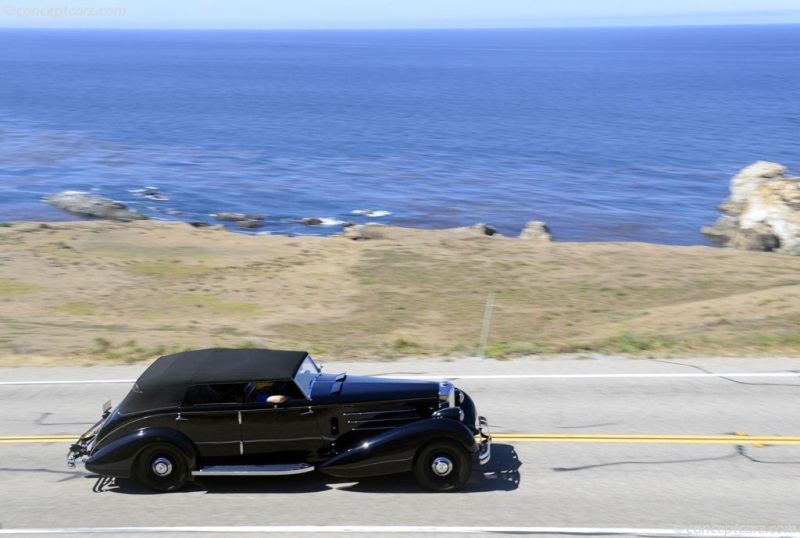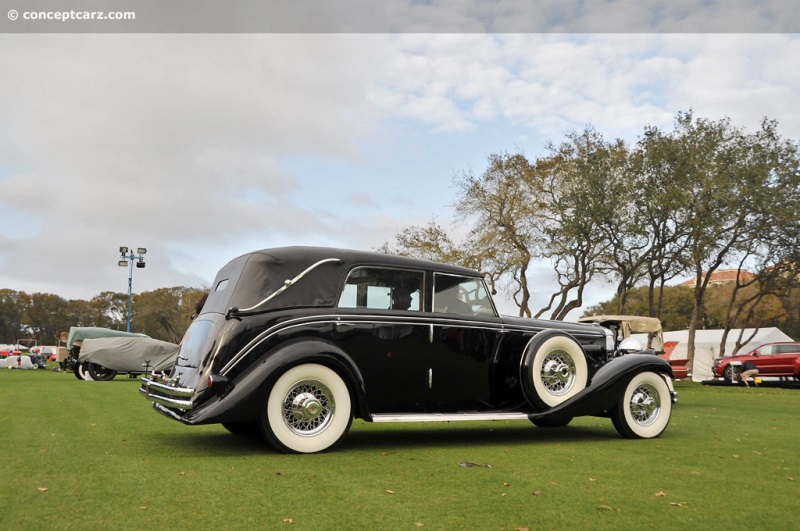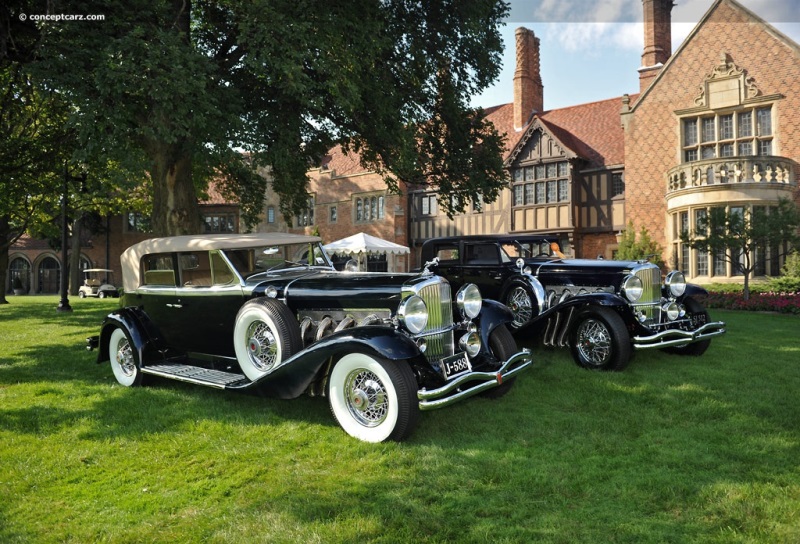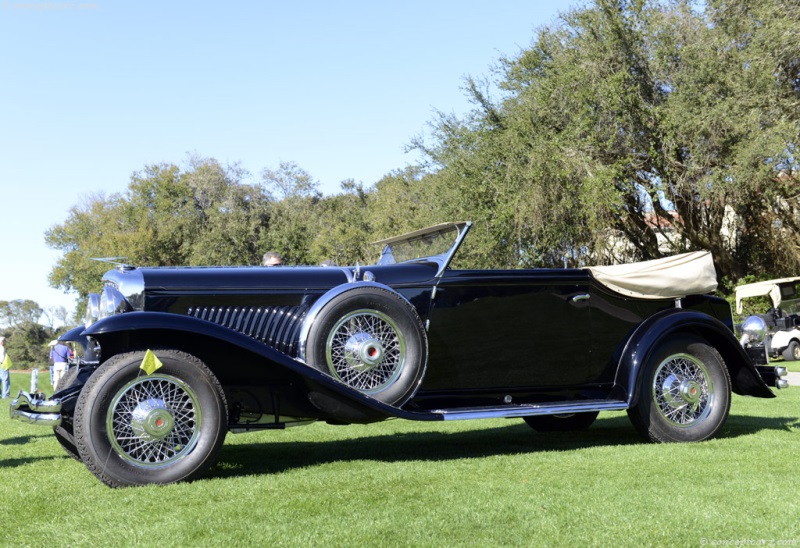The Duesenberg Model J was the most luxurious and most powerful automobile available when it was introduced in 1928, a year prior to the stock market crash that led to the Great Depression. Fred and August Duesenberg founded the Duesenberg Company in Indianapolis, Indiana in 1920 and infused with the brother's knowledge and expertise forged in motorsports and years of building automobiles. The brothers designed their first engines during the early 1900s, their first vehicle in 1905, and a year later formed the Mason Motor Car Company with financial assistance from Edward R. Mason. After Frederick Maytag I and Elmer Henry Maytag acquired a majority stake in the company, it was renamed the Maytag-Mason Automobile Company. The Duesenberg brothers sold their stake in the company in 1912 and relocated to Saint Paul, Minnesota, where they formed the Duesenberg Automobile and Motors Company. The first Duesenberg-designed vehicle was driven by Eddie Rickenbacker at the 1914 Indianapolis 500 and placed tenth overall. The company's aircraft engines used during World War I was built in Elizabeth, New Jersey.
After relocating to Indianapolis, Indiana in 1920, the re-launched Duesenberg company focused on automobile production with their Model A. It was powered by a 260 cubic-inch straight-eight engine that offered nearly 90 horsepower. At the time, it was the largest engine in a commercially available vehicle, and the first to employ hydraulic brakes on all four wheels.
Competition remained paramount to the Duesenberg marque as they participated in the 1922, 1924, 1925, and 1927 editions of the Indianapolis 500. In 1921, they became the first American car to win the French Grand Prix.
Many companies suffered due to the sharp deflationary recession in the United States during the very early 1920s, and Duesenberg was no different. By 1924, despite their accomplishments, had entered receivership. The company was saved in 1926 by Errett Lobban Cord who added it to his growing empire of businesses. From this period forward, August primarily worked on the company's racing endeavors while Fred was given the title of vice president in charge of engineering and experimental work.
The Duesenberg Model J
The Model J was introduced on December 1st of 1928 at the New York Car Show. The car on display housed engine number J-101 and wore a LeBaron sweep panel dual cowl phaeton body painted in silver and black. The following year, it was displayed at the Salon de l'automobile de Paris.
The company hoped to build 500 examples per year, but by the time the Great Depression occurred in October of 1929, only around 200 examples had been constructed. The first customer delivery came in May 1929, barely five months before Black Tuesday. Around 100 examples were built the following year and 481 units during its eight-year production lifespan. Most of the chassis and engines were built in 1929 and 1930. The year associated with specific Duesenberg often refers to when it received its coachwork.
At the heart of the Duesenberg was a straight eight motor designed by Duesenberg using engineering principles employed by its earlier racing endeavors. Beginning with their first appearance in 1913, 70 Duesenbergs would compete in 15 consecutive Indianapolis 500s, with thirty-two of those (46 percent of them) finishing in the top 10. This success was due to the engine's performance and reliability, and its construction was on par with the best from Peugeot, Ballot, and Miller. In 1922, eight of the top 10 cars to cross the finish line at the Indianapolis 500 were Duesenberg-powered. The car driven by Jimmy Murphy to victory, known as the 'Murphy Special, utilized a Duesenberg chassis and Miller engine.
The manufacturing of the Model J engines was performed by Lycoming, another company owned by Cord. It had dual overhead camshafts, four valves per cylinder, a 3.74-inch cylinder bore, a 4.76-inch piston stroke, cast iron block and head, a 5.7:1 compression ratio, and developed 265 horsepower in naturally aspirated configuration. It used a single updraft Schleber carburetor and from 1932 forward, a Duesenberg centrifugal supercharger was offered, boosting output to 320 bhp. The supercharged SSJ was capable of producing approximately 400 horsepower. A total of 36 examples were the supercharged Model SJ.
The JN series was introduced in 1935 and was the company's attempt at infusing the Model J's image with a clean and modern appearance with refined aesthetics, elegant proportions, and streamlined contours. For this monumental task, Duesenberg commissioned Rollston of New York City to fashion a line of tasteful body styles. The three body styles were offered including convertible coupes and convertible sedans on the standard-length chassis, and sports sedans on the long-wheelbase chassis. It is believed that only 10 JNs were built, of which four examples were bodied as convertible coupes, style number 434. All of the Rollston-bodied JN models were delivered to Duesenberg 'in the white,' ready for paint and trim to customer preference.
The Model J rested on a 'short' 142.5-inch wheelbase chassis or a longer version that measured 153.5 inches. Two SSJ models were built on a short 125-inches and a few examples rested on a 160-inch platform. Each chassis was driven at speed for 100 miles at the Indianapolis Motor Speedway.
Early examples received a four-speed gearbox, but since it proved inadequate with coping with the engine's power, an unsynchronised three-speed gearbox was subsequently fitted to all Duesenbergs.
Coachwork
The Duesenberg Model J was expensive with final costs in the vicinity of $20,000. A short wheelbase chassis (devoid of coachwork) cost approximately $8,500. At the time, a new family sedan could be purchased for around $500. Thus, only the most affluent of society were capable of purchasing a Duesenberg. The exorbitant fee rewarded its new owner with the distinction of having the best that money could buy.
The new Duesenberg was tailor-made for the custom body industry, offering both a generous platform and plenty of power to carry the large and luxurious coachwork. Among the list of coachbuilders who created bodies for the Model J, the Murphy body company of Pasadena, California is generally recognized as the most successful, creating more bodies than any other single coachbuilder. Approximately half of the Model Js had coachwork devised by the company's chief body designer, Gordon Buehrig, and built under the name La Grande by company branches in Chicago, New York City, Los Angeles, Philadelphia, Florida, and Denver. Among the list of independent US coachbuilders were the aforementioned Murphy, Rollston (later renamed Rollson), Le Baron, Derham, Holbrook, Judkins, Weymann, Willoughby, and Walker. European coachbuilders included Saoutchik, Franay, Fernandez et Darrin, and Gurney Nutting.
With a top speed of nearly 120 miles per hour, the Model J was indeed the most expensive and fastest American automobile on the market. A unique Duesenberg Special was commissioned by Ab Jenkins with the purpose of establishing land speed records. The supercharged example, later renamed the 'Mormon Meteor', was built in 1935 and was driven by Jenkins in October of that year to a one-hour record of 153.97 mph and a twenty-four-hour record of 135.57 mph. The 24-hour record would be held until 1961.
Cord's empire collapsed in 1937, signaling the demise of the Duesenberg marque. In its brief existence under E.L. Cord's control, it had succeeded in its task of building the finest production automobile.
by Daniel Vaughan | Oct 2022
After relocating to Indianapolis, Indiana in 1920, the re-launched Duesenberg company focused on automobile production with their Model A. It was powered by a 260 cubic-inch straight-eight engine that offered nearly 90 horsepower. At the time, it was the largest engine in a commercially available vehicle, and the first to employ hydraulic brakes on all four wheels.
Competition remained paramount to the Duesenberg marque as they participated in the 1922, 1924, 1925, and 1927 editions of the Indianapolis 500. In 1921, they became the first American car to win the French Grand Prix.
Many companies suffered due to the sharp deflationary recession in the United States during the very early 1920s, and Duesenberg was no different. By 1924, despite their accomplishments, had entered receivership. The company was saved in 1926 by Errett Lobban Cord who added it to his growing empire of businesses. From this period forward, August primarily worked on the company's racing endeavors while Fred was given the title of vice president in charge of engineering and experimental work.
The Duesenberg Model J
The Model J was introduced on December 1st of 1928 at the New York Car Show. The car on display housed engine number J-101 and wore a LeBaron sweep panel dual cowl phaeton body painted in silver and black. The following year, it was displayed at the Salon de l'automobile de Paris.
The company hoped to build 500 examples per year, but by the time the Great Depression occurred in October of 1929, only around 200 examples had been constructed. The first customer delivery came in May 1929, barely five months before Black Tuesday. Around 100 examples were built the following year and 481 units during its eight-year production lifespan. Most of the chassis and engines were built in 1929 and 1930. The year associated with specific Duesenberg often refers to when it received its coachwork.
At the heart of the Duesenberg was a straight eight motor designed by Duesenberg using engineering principles employed by its earlier racing endeavors. Beginning with their first appearance in 1913, 70 Duesenbergs would compete in 15 consecutive Indianapolis 500s, with thirty-two of those (46 percent of them) finishing in the top 10. This success was due to the engine's performance and reliability, and its construction was on par with the best from Peugeot, Ballot, and Miller. In 1922, eight of the top 10 cars to cross the finish line at the Indianapolis 500 were Duesenberg-powered. The car driven by Jimmy Murphy to victory, known as the 'Murphy Special, utilized a Duesenberg chassis and Miller engine.
The manufacturing of the Model J engines was performed by Lycoming, another company owned by Cord. It had dual overhead camshafts, four valves per cylinder, a 3.74-inch cylinder bore, a 4.76-inch piston stroke, cast iron block and head, a 5.7:1 compression ratio, and developed 265 horsepower in naturally aspirated configuration. It used a single updraft Schleber carburetor and from 1932 forward, a Duesenberg centrifugal supercharger was offered, boosting output to 320 bhp. The supercharged SSJ was capable of producing approximately 400 horsepower. A total of 36 examples were the supercharged Model SJ.
The JN series was introduced in 1935 and was the company's attempt at infusing the Model J's image with a clean and modern appearance with refined aesthetics, elegant proportions, and streamlined contours. For this monumental task, Duesenberg commissioned Rollston of New York City to fashion a line of tasteful body styles. The three body styles were offered including convertible coupes and convertible sedans on the standard-length chassis, and sports sedans on the long-wheelbase chassis. It is believed that only 10 JNs were built, of which four examples were bodied as convertible coupes, style number 434. All of the Rollston-bodied JN models were delivered to Duesenberg 'in the white,' ready for paint and trim to customer preference.
The Model J rested on a 'short' 142.5-inch wheelbase chassis or a longer version that measured 153.5 inches. Two SSJ models were built on a short 125-inches and a few examples rested on a 160-inch platform. Each chassis was driven at speed for 100 miles at the Indianapolis Motor Speedway.
Early examples received a four-speed gearbox, but since it proved inadequate with coping with the engine's power, an unsynchronised three-speed gearbox was subsequently fitted to all Duesenbergs.
Coachwork
The Duesenberg Model J was expensive with final costs in the vicinity of $20,000. A short wheelbase chassis (devoid of coachwork) cost approximately $8,500. At the time, a new family sedan could be purchased for around $500. Thus, only the most affluent of society were capable of purchasing a Duesenberg. The exorbitant fee rewarded its new owner with the distinction of having the best that money could buy.
The new Duesenberg was tailor-made for the custom body industry, offering both a generous platform and plenty of power to carry the large and luxurious coachwork. Among the list of coachbuilders who created bodies for the Model J, the Murphy body company of Pasadena, California is generally recognized as the most successful, creating more bodies than any other single coachbuilder. Approximately half of the Model Js had coachwork devised by the company's chief body designer, Gordon Buehrig, and built under the name La Grande by company branches in Chicago, New York City, Los Angeles, Philadelphia, Florida, and Denver. Among the list of independent US coachbuilders were the aforementioned Murphy, Rollston (later renamed Rollson), Le Baron, Derham, Holbrook, Judkins, Weymann, Willoughby, and Walker. European coachbuilders included Saoutchik, Franay, Fernandez et Darrin, and Gurney Nutting.
With a top speed of nearly 120 miles per hour, the Model J was indeed the most expensive and fastest American automobile on the market. A unique Duesenberg Special was commissioned by Ab Jenkins with the purpose of establishing land speed records. The supercharged example, later renamed the 'Mormon Meteor', was built in 1935 and was driven by Jenkins in October of that year to a one-hour record of 153.97 mph and a twenty-four-hour record of 135.57 mph. The 24-hour record would be held until 1961.
Cord's empire collapsed in 1937, signaling the demise of the Duesenberg marque. In its brief existence under E.L. Cord's control, it had succeeded in its task of building the finest production automobile.
by Daniel Vaughan | Oct 2022
Background
The Duesenberg Company produced high-end, luxury automobiles and racing cars from 1913 through 1937. It was created by the Duesenberg brothers, Fred and August, who formed the Duesenberg Automobile %26 Motors Company, Inc. in Des Moines, Iowa with the intent on building sports cars. Just like many of their time, they were mostly self-taught engineers and had only constructed experimental cars up to....
Continue Reading >>
Continue Reading >>
Related Reading : Duesenberg Model J History
The Duesenberg Automobile %26 Motors Company, Inc was founded and operated by Fred and August, brothers who began their company in 1913. From the start, the company has been a US-based luxury automobile company with a standard to build the very best hand-built vehicles during the time period. Duesenberg vehicles lived up to this standard until 1937 when the company closed. Created to build sports....
Continue Reading >>
Continue Reading >>
1936 Duesenberg Model J Vehicle Profiles
Recent Vehicle Additions
Performance and Specification Comparison
Model J Specification Comparison by Year
Year
Production
Wheelbase
Engine
Prices
125.00 in., 142.50 in.
8 cyl., 420.00 CID., 265.00hp
8 cyl., 420.00 CID., 320.00hp
8 cyl., 420.00 CID., 320.00hp
$8,500 - $8,500
Related Automotive News

The First-Ever AAR Gurney Eagle, Accompanied by Roster of American Automotive All-Stars, Announced for Gooding & Company's Amelia Island Auctions
The auction house is offering the very first AAR Gurney Eagle Mk 1 at its upcoming Amelia Island Auctions, as well as a 1931 Duesenberg Model J Convertible Sedan, a 1935 Auburn 851 SC Boattail Speedster, and other select American icons.
Gooding...

Past Best of Show Winners at The Pebble Beach Concours d'Elegance
overview1
The 70th anniversary of the Pebble Beach Concours dElegance was celebrated with a spectacular display of previous Best of Show winners. Thirty-seven examples graced the showfield and many were still with the same owners who raised the trophy...

Elegance at The Quail, A Motorsport Gathering
Among the most elegant vehicles at this years The Quail, A Motorsport Gathering - in our opinion - were the 1931 Duesenberg Model J, a Horch 853, and the Mercedes-Benz 540K.
The Duesenberg
The Model J was the most powerful...

The Most Valuable Road-Going Car in Auction History Sells at RM Auctions' Historic $125,000,000 Monterey Sale
During a weekend sale that will surely go down in collector car auction history, RM grosses in excess of %24125,000,000 as a total of 120 vehicles cross the podium on the Monterey Peninsula, breaking the world record for the highest sales total for a...

Final Countdown Underway to RM's Michigan Sale
RM Auctions, the official auction house of the Concours dElegance of America, has secured a wonderful selection of classic automobiles for its St. Johns sale, July 28, in Plymouth, Michigan.
Hosted on the beautiful grounds of the Inn at St. Johns,...



































